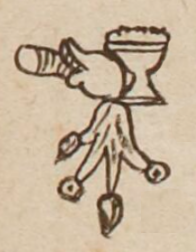Aoc Tlacuani (Verg6r)
This black-line drawing of the compound glyph for the personal name Aoc Tlacuani (“He Is No Longer a Glutton,” attested here as a man’s name) shows a spray of four little streams of water (atl) with their usual black lines of current and alternating droplets and turbinate shells at the ends of each stream. Above the water, on the viewer's right-hand side, is a cup of pulque (octli) with bubbles at the top. To the left of this cup is a mouth with prominent front teeth and a large piece food coming out of its mouth. This points to the noun tlacuani, one who eats too much or a glutton.
Stephanie Wood
The entire pronoun for "No Longer" (Aoc) is represented with two phonetic indicators. The other element is a logogram for glutton (tlacuani).
Stephanie Wood
vicēte.aoctlacuani
VIcente Aoc Tlacuani
Stephanie Wood
1539
Jeff Haskett-Wood
agua, glutones, pulque, ya no, nunca más

aoc, no longer, https://nahuatl.wired-humanities.org/content/aoc
oc(tli), pulque, https://nahuatl.wired-humanities.org/content/octli
tlacuani, a glutton, https://nahuatl.wired-humanities.org/content/tlacuani
cua, to eat, https://nahuatl.wired-humanities.org/content/cua
Él Ya No Es Un Glotón
Stephanie Wood
Codex Vergara, folio 6r, https://gallica.bnf.fr/ark:/12148/btv1b84528032/f19.item
The non-commercial reuse of images from the Bibliothèque nationale de France is free as long as the user is in compliance with the legislation in force and provides the citation: “Source gallica.bnf.fr / Bibliothèque nationale de France” or “Source gallica.bnf.fr / BnF.” We would also appreciate a citation to the Visual Lexicon of Aztec Hieroglyphs, https://aztecglyphs.wired-humanities.org/.


